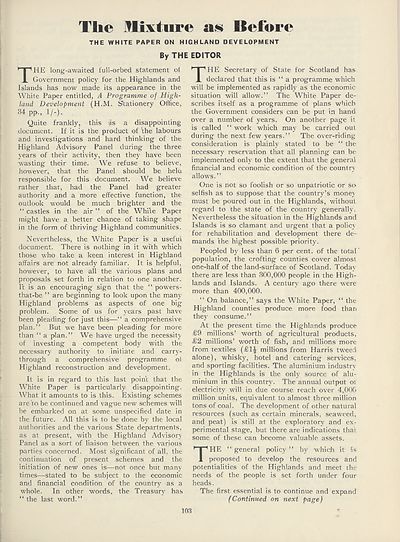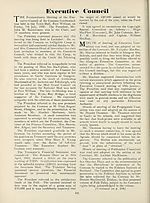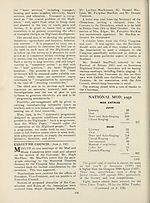An Comunn Gàidhealach Publications > Gaidheal > Volumes 44--45, January 1949--December 1950
(443) Page 103
Download files
Complete book:
Individual page:
Thumbnail gallery: Grid view | List view

The Mixture as Before
THE WHITE PAPER ON HIGHLAND DEVELOPMENT
By THE EDITOR
THE long-awaited full-orbed statement of
Government policy for the Highlands and
Islands has now made its appearance in the
White Paper entitled, A Programme of High¬
land Development (H.M. Stationery Office,
34 pp., 1/-).
yuite frankly, this (is a disappointing
document. If it is the product of the labours
and investigations and hard thinking of the
Highland Advisory Panel during the three
years of their activity, then they have been
wasting their time. We refuse to believe,
however, that the Panel should be helo
responsible for this document. We believe
rather that, had the Panel had greater
authority and a more effective function, the
outlook would be much brighter and the
“castles in the air” of the White Paper
might have a better chance of taking shape
in the form of thriving Highland communities.
Nevertheless, the White Paper is a useful
document. There is nothing in it with which
those who take a keen interest in Highland
affairs are not already familiar. It is helpful,
however, to have all the various plans and
proposals set forth in relation to one another.
It is an encouraging sign that the “ powers-
that-be ” are beginning to look upon the many
Highland problems as aspects of one big
problem. Some of us for years past have
been pleading for just this—“ a comprehensive
plan.” But we have been pleading for more
than “ a plan.” We have urged the necessity
of investing a competent body with the
necessary authority to initiate and carry-
through a comprehensive programme ol
Highland reconstruction and development.
It is in regard to this last point that the
White Paper is particularly disappointing.
What it amounts to is this. Existing schemes
are to be continued and vague new schemes will
be embarked on at some unspecified date in
the future. All this is to be done by the local
authorities and the various State departments,
as at present, with the Highland Advisory
Panel as a sort of liaison between the various
parties concerned. Most significant of all, the
continuation of present schemes and the
initiation of new ones is—not once but many
times—stated to be subject to the economic
and financial condition of the country as a
whole. In other words, the Treasury has
“ the last word.”
THE Secretary of State for Scotland has
declared that this is “ a programme which
will be implemented as rapidly as the economic
situation will allow.” The White Paper de¬
scribes Itself as a programme of plans which
the Government considers can be put in hand
over a number of years. On another page it
is called “ work which may be carried out
during the next few years.” The over-riding
consideration is plainly stated to be “ the
necessary reservation that all planning can be
implemented only to the extent that the general
financial and economic condition of the country
allows.”
One is not so foolish or so unpatriotic or so
selfish as to suppose that the country’s money
must be poured out in the Highlands, without
regard to the state of the country generally.
Nevertheless the situation in the Highlands and
Islands is so clamant and urgent that a policy
for rehabilitation and development there de¬
mands the highest possible priority.
Peopled by less than 6 per cent, of the total
population, the crofting counties cover almost
one-half of the land-surface of Scotland. Todav
there are less than 300,000 people in the High¬
lands and Islands. A century ago there were
more than 400,000.
“ On balance,” says the White Paper, “ the
Highland counties produce more food than
they consume.”
At the present time the Highlands produce
£9 millions’ worth of agricultural products,
£2 millions’ worth of fish, and millions more
from textiles (£1^ millions from Harris tweed
alone), whisky, hotel and catering services,
and sporting facilities. The aluminium industry
in the Highlands is the only source of alu¬
minium in this country. The annual output oi
electricity will in due course reach over 4,000
million units, equivalent to almost three million
tons of coal. The development of other natural
resources (such as certain minerals, seaweed,
and peat) is still at the exploratory and ex¬
perimental stage, but there are indications that
some of these can become valuable assets.
THE “ general policy ” by which it Ss
proposed to develop the resources and
potentialities of the Highlands and meet the
needs of the people is set forth under four
heads.
The first essential is to continue and expand
(Continued on next page)
103
THE WHITE PAPER ON HIGHLAND DEVELOPMENT
By THE EDITOR
THE long-awaited full-orbed statement of
Government policy for the Highlands and
Islands has now made its appearance in the
White Paper entitled, A Programme of High¬
land Development (H.M. Stationery Office,
34 pp., 1/-).
yuite frankly, this (is a disappointing
document. If it is the product of the labours
and investigations and hard thinking of the
Highland Advisory Panel during the three
years of their activity, then they have been
wasting their time. We refuse to believe,
however, that the Panel should be helo
responsible for this document. We believe
rather that, had the Panel had greater
authority and a more effective function, the
outlook would be much brighter and the
“castles in the air” of the White Paper
might have a better chance of taking shape
in the form of thriving Highland communities.
Nevertheless, the White Paper is a useful
document. There is nothing in it with which
those who take a keen interest in Highland
affairs are not already familiar. It is helpful,
however, to have all the various plans and
proposals set forth in relation to one another.
It is an encouraging sign that the “ powers-
that-be ” are beginning to look upon the many
Highland problems as aspects of one big
problem. Some of us for years past have
been pleading for just this—“ a comprehensive
plan.” But we have been pleading for more
than “ a plan.” We have urged the necessity
of investing a competent body with the
necessary authority to initiate and carry-
through a comprehensive programme ol
Highland reconstruction and development.
It is in regard to this last point that the
White Paper is particularly disappointing.
What it amounts to is this. Existing schemes
are to be continued and vague new schemes will
be embarked on at some unspecified date in
the future. All this is to be done by the local
authorities and the various State departments,
as at present, with the Highland Advisory
Panel as a sort of liaison between the various
parties concerned. Most significant of all, the
continuation of present schemes and the
initiation of new ones is—not once but many
times—stated to be subject to the economic
and financial condition of the country as a
whole. In other words, the Treasury has
“ the last word.”
THE Secretary of State for Scotland has
declared that this is “ a programme which
will be implemented as rapidly as the economic
situation will allow.” The White Paper de¬
scribes Itself as a programme of plans which
the Government considers can be put in hand
over a number of years. On another page it
is called “ work which may be carried out
during the next few years.” The over-riding
consideration is plainly stated to be “ the
necessary reservation that all planning can be
implemented only to the extent that the general
financial and economic condition of the country
allows.”
One is not so foolish or so unpatriotic or so
selfish as to suppose that the country’s money
must be poured out in the Highlands, without
regard to the state of the country generally.
Nevertheless the situation in the Highlands and
Islands is so clamant and urgent that a policy
for rehabilitation and development there de¬
mands the highest possible priority.
Peopled by less than 6 per cent, of the total
population, the crofting counties cover almost
one-half of the land-surface of Scotland. Todav
there are less than 300,000 people in the High¬
lands and Islands. A century ago there were
more than 400,000.
“ On balance,” says the White Paper, “ the
Highland counties produce more food than
they consume.”
At the present time the Highlands produce
£9 millions’ worth of agricultural products,
£2 millions’ worth of fish, and millions more
from textiles (£1^ millions from Harris tweed
alone), whisky, hotel and catering services,
and sporting facilities. The aluminium industry
in the Highlands is the only source of alu¬
minium in this country. The annual output oi
electricity will in due course reach over 4,000
million units, equivalent to almost three million
tons of coal. The development of other natural
resources (such as certain minerals, seaweed,
and peat) is still at the exploratory and ex¬
perimental stage, but there are indications that
some of these can become valuable assets.
THE “ general policy ” by which it Ss
proposed to develop the resources and
potentialities of the Highlands and meet the
needs of the people is set forth under four
heads.
The first essential is to continue and expand
(Continued on next page)
103
Set display mode to:
![]() Universal Viewer |
Universal Viewer | ![]() Mirador |
Large image | Transcription
Mirador |
Large image | Transcription
| An Comunn Gàidhealach > An Comunn Gàidhealach Publications > Gaidheal > Volumes 44--45, January 1949--December 1950 > (443) Page 103 |
|---|
| Permanent URL | https://digital.nls.uk/127127352 |
|---|
| Description | This contains items published by An Comunn, which are not specifically Mòd-related. It includes journals, annual reports and corporate documents, policy statements, educational resources and published plays and literature. It is arranged alphabetically by title. |
|---|
| Description | A collection of over 400 items published by An Comunn Gàidhealach, the organisation which promotes Gaelic language and culture and organises the Royal National Mòd. Dating from 1891 up to the present day, the collection includes journals and newspapers, annual reports, educational materials, national Mòd programmes, published Mòd literature and music. |
|---|---|
| Additional NLS resources: |
|

